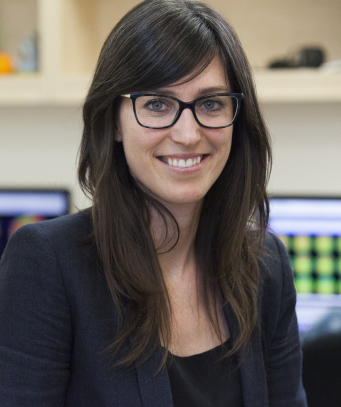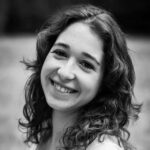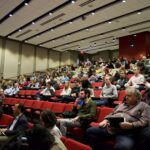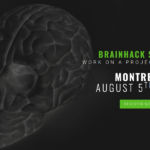Exceptionally this year, QBIN will be awarding two Professors the Rising Star in Bio-Imaging in Quebec award, Profs. Sylvia Villeneuve and Hassan Rivaz, who will present their work at the 2022 QBIN Scientific Day in Sherbrooke on June 2nd along with this year’s William Feindel lecturer, Louis Collins. In order to learn more about their research and interests, the QBIN blog team conducted interviews with each of them. Stay tuned for interviews with Hassan Rivaz and Louis Collins soon and enjoy the interview with Sylvia Villeneuve below!
Sylvia Villeneuve is Associate Professor in the Department of Psychiatry at McGill University and holds a Canada Research Chair in Early Detection of Alzheimer’s Disease. She directs the Multimodal Imaging of the Aging Brain lab at the Douglas Institute, where she is also co-director of the StoP-AD Center. Her research agenda focuses on aging and Alzheimer’s disease, primarily the preclinical form of the disease, with the aim of better understanding biological and brain changes before the onset of cognitive decline. Like the previous Rising Stars, Prof. Villeneuve combines scientific rigor, a positive attitude and innovative ideas! I had the chance to discuss her background and vision of research with her, which will no doubt inspire many. (Note: the interview has been translated from French and edited for length and clarity)
Who is Sylvia Villeneuve?
I completed my bachelor’s degree at UQAM in psychology where I did an honors thesis on child development. I then obtained my doctorate in neuropsychology in research and intervention under the supervision of Sylvie Belleville at Université de Montréal. In my thesis I developed memory tasks to differentiate between patients with vascular-type mild cognitive impairment vs. Alzheimer’s type. In fact my interest in Alzheimer’s disease started very early, I participated in a science fair in elementary school with a project on Alzheimer’s disease! After my doctorate, I then did a post-doctorate at Berkeley with William Jagust in connection with amyloid imaging in Alzheimer’s disease. Amyloid is one of the two pathologies of Alzheimer’s disease – the other being the aggregates of tau proteins that can be measured in the brain using positron emission tomography (PET). I did another short postdoc at NorthWestern University before being hired at McGill.
When did you know you wanted to pursue a career in research rather than clinical neuropsychology?
I would say that it became clearer towards the end of my doctorate, during the clinical internship. I realized that at this time, when we were exclusively in the clinic, I missed research. It was during my first postdoc that I realized that I wanted to become a professor and really pursue a career in research. That being said, I consider myself a better researcher because of my clinical training! This training still serves me well and my current research is closely linked to clinical applications. What excites me about my research agenda is the aim of having a clinical impact on Alzheimer’s disease.
Speaking of which, what excites you the most about your current research?
We are in an era where we constantly have new biomarkers to better understand Alzheimer’s disease! For example, during my postdoc, amyloid PET scans were already established. Then, soon after I started at McGill, PET scans for tau (the second pathology of Alzheimer’s disease) were developed and we were among the few groups in the world to acquire these new scans. With all these biomarkers, we are also able to study the disease earlier and earlier, before the appearance of symptoms of the disease, in what is called the preclinical phase. Amyloid is precisely the pathology that begins to accumulate very early in this preclinical phase and this is what motivated my choice of postdoc – I wanted to work on early biomarkers. Another aspect that I find important in my current research agenda is that we really try to include multimodal imaging. Given that we study people before the onset of cognitive disorders and therefore cannot base everything on clinical expression, it is important to combine several cerebral markers.
Also, I really feel that our research has an impact in the clinic. For example, the information on the biomarkers that we acquire in research on our participants is shared with the neurologists, which influences the management of the patient. Our research has an important clinical significance and this is an aspect that is close to my heart!
You are also co-director of the StoP-Alzheimer Center at the Douglas. How do you reconcile this role with the management of your research laboratory?
It makes it possible to bridge the gap between research and the clinic in fact! In my laboratory, we focus mainly on multimodal imaging using the participants we see at the StoP-AD center. We have a more “technical” approach, let’s say. Then, we link all that with clinical data and we can communicate the results from my laboratory with clinicians and neurologists, as I said. It allows the research to have a wider scope beyond the academic aspect.
We also share imaging, biomarker and cognition data (…and more to come soon!) from the cohort of participants who come to the StoP-Alzheimer center openly. I think it’s great that this data can be used by so many researchers around the world!
It’s interesting that you mention open science. Did you hesitate before embarking on sharing all this data (2000 MRI scans and 5 years of cognitive monitoring) or did this choice come naturally to you?
I think it’s important to share data to advance science. Most of the research projects in my lab, by the way, often use multiple cohorts to replicate results, so I would say it was natural to embark on this process to help with this data sharing. On the other hand, I would say that one of the major challenges we have encountered is that there is not really a structure in place to promote the sharing of sensitive clinical data. At the ethical level we also asked ourselves several questions. The decisions on what we could or could not share differed from one committee to another according to the organizations. So to get all the imaging and clinical data harmonized, to ask for consent from each participant, it was a long process! Funding for this type of initiative is also still limited, so it required a lot of “extra” time to do that! Also, don’t underestimate all the time needed to answer questions and requests from users and maintain the platform. In the long term it would be great if we could have stable structures to facilitate these data sharing initiatives.
What advances do you see in relation to imaging and Alzheimer’s disease in the future?
I think we have reached the point where we can transpose research results into the clinic. For example, it is increasingly clear that in older people without cognitive impairment, having high levels of amyloid and tau is closely linked to cognitive decline within a few years. This is the kind of information that can really make a difference to patient care and the design of clinical trials. Also, I think multimodal imaging is on the rise; by combining several cerebral markers we are able to better understand the heterogeneity of Alzheimer’s disease and aging. We realize more and more the great interindividual variability. Being able to approach it from different angles with different imaging modalities helps us to better understand the evolution of the disease, especially before the onset of symptoms.
Who are your mentors and what do you value most about your relationships with them?
At the clinical level, Sylvie Belleville is one of the best clinicians I know. Her research agenda has also been greatly influenced by her clinical expertise and this is an aspect that resonates with me a lot. During my clinical internships, I was also greatly influenced by other clinicians, in particular Francine Fontaine, an incredible clinical neuropsychologist who was at CRIUGM during my training. In terms of research, Bill Jagust has been and still is to this day a great mentor for me! His innovative way of approaching research questions, managing his team and training students is truly an inspiration to me.
In your lab, what type of mentor are you?
Hmmm good question! I love training students. My goal is to help them in their training so that they become experts in their field and that their expertise exceeds mine when they leave the lab. I really want to help them in this process of “learning to think” so that they become independent later on and develop their own ideas. For me it is important that all members of my laboratory, regardless of their level of education or expertise, participate in all aspects of the research. My postdocs as well as my undergraduate students participate in, for example, data collection, data entry, and review of grant applications. The new and enlightening look that my undergraduate students have on my grant applications is often enlightening. They find the flaws and are extremely helpful in helping me identify overly complex sections that need to be explained more simply.
You have been in the job for a few years now, what advice would you give to someone who wants to be a professor?
I would advise you to go there with your passion – the basic criterion in my opinion is to be passionate! I also think it’s important to find a postdoc position that will train you well. My postdoc was very challenging and at the same time it really prepared me to become an independent researcher. And obviously surrounding yourself with good mentors is also very important!
How do you approach failure in science and what is your action plan after failure?
Failure is paramount! I often see it as a sign that there is something to change and improve. For example, when my grant applications are not funded, it motivates me to improve them and succeed in transforming them into success. I really think that we become better researchers because of failures!
Did you learn anything about yourself or how you conduct your research during the pandemic?
At the StoP-AD center, the pandemic has been very difficult. We had to reinvent the annual visits with the participants who are all elderly people by setting up cognitive tasks that can be done virtually. And of course we had to cancel all the brain imaging visits. In terms of my lab, I realized how extremely important one-on-one contact with my students is. I like to work closely with my team and although we have put certain things in place, it is still more difficult virtually. My lab is really a place where we help each other and in a way the pandemic has confirmed how important that is to me.
How do you manage to find the balance between work and personal life?
I think it’s super important to have hobbies and activities outside of work. Even having these activities and/or a family forces us to be efficient. It’s also important to take a vacation! Each time, these rest periods allow me to come back even more motivated. When I come back from vacation I always have a paper and a pencil on the way back and I think about my next grant applications! Moreover, when I wrote my first CIHR application, I arrived towards the end and I had an almost final version, but that little something was missing to make it a more complete version and I was stuck! I couldn’t improve it as I wanted so the weekend just before the submission I went skiing for half a day to clear my mind and disconnect (I love downhill skiing). When I got back to it, it unlocked and I was able to improve it! All that to say that it’s super important to have this balance!
Very good advice to take breaks! It was very beneficial in this case since the request was subsidized!
What is something that most people don’t know about you?
People sometimes have the impression that I am very structured and organized…. But it’s not always the case! Moreover, each grant application, regardless of the date or time of the deadline, I submit it two minutes before the deadline!
(Laughs) That’s so true! (Dr. Villeneuve was my PhD supervisor)
Finally, what does it mean for you to receive the Rising Star award from the RBIQ?
For me it’s really an important prize because it’s often difficult to have the hat of someone with technical skills in neuroimaging and as a clinician. Sometimes I am put in this category of “clinician” and some see it as incompatible with generating cutting-edge advances in brain imaging. For me there is no incompatibility. In my lab we innovate in imaging and then there is a transfer of knowledge at the StoP-AD center. This award recognizes these different facets!
Now here are some quick-fire questions for you!
The Douglas or the MNI? (Professor Villeneuve’s laboratory is at the Douglas Institute)
The Douglas …. but it’s both!
Open data or acquire data?
Oh, both again! But still a little penchant for acquiring data!
MRI or PET?
PET, that’s for sure!
I’m curious here, amyloid or tau?
(After reflection) Amyloid
I really think that if we can stop amyloid it would be beneficial for preventing Alzheimer’s disease.
Introvert or extrovert?
Extrovert … but definitely both
Summer or Winter?
Winter
Coffee or tea?
Coffee!!
Montreal bagels or poutine?
Bagels…. I could even specify Saint-Viateur!
Alexa was a PhD student at McGill University under the supervision of Prof Sylvia Villeneuve. She is now continuing to work on neuroimaging in Alzheimer's disease as a postdoc at Lund University, Sweden, and hopes to some day have a lab of her own in Quebec!




